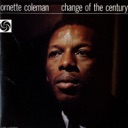Free Jazz/Avant-Garde
Anthony Braxton at the International Jazz Festival, Prague, 1984
Gampe, CC BY-SA 4.0, via Wikimedia CommonsKey Attributes of Free Jazz/Avant-Garde
Select to filter timelineThemes
- Daily Life
- Black Power/Pride
- Economics/Poverty
- Political Issues/Activism
- Racism/Discrimination
- Civil Rights
Musical Features
- Improvisation
- Rhythms
- Vocals
- Instrumentals
Instruments
- Saxophone
“Cecil Taylor’s left hand is used as much as a purely rhythmic insistence as it is for the melodic-harmonic placement of chords. The left hand constantly varies the rhythms his music is hinged on.”LeRoi JonesAuthor and Cultural Activist
Bebop and its spinoffs of the 1940s and ’50s took jazz to places that had been unimaginable to earlier generations of fans. During the following decades, the music continued to stretch limits. Whether labeled free jazz or avant-garde, the abstract sounds, dissonant harmonies, and free rhythms of the turbulent 1960s and ’70s provided an edgy, challenging, and often chaotic soundtrack for a nation in turmoil. While inner cities burned and violent demonstrations rattled the country’s nerves, this new jazz echoed the confusion, anger, and frustration of its time (as did its popular counterpart, soul music). Against the backdrop of the Civil Rights and Black Power movements and the Vietnam War protests, free jazz acquired a nationalist and revolutionary identity.
Context and History
Critical reaction to the free jazz movement was often hostile at first, and most musicians had difficulty booking gigs and getting record companies to take interest in their music. Historically, most jazz clubs were created for “mainstream” sounds, and audiences were somewhat averse to the demands made by the new music coming from Ornette Coleman’s “Free” (1960), Cecil Taylor’s “Unit Structures” (1966), and Anthony Braxton’s For Alto (1969), among others.
“Ornette Coleman is also the one whose innovations have been most challenged by many jazz critics and musicians whose shortsightedness makes it difficult for them to accept the genuinely new.”LeRoi JonesAuthor and Cultural Activist
The ideology associated with the Civil Rights and Black Power movements inspired the political titles of many songs and the content for concept albums. Art Blakey and the Jazz Messengers’ “The Freedom Rider” (1964), and Charles Mingus’s “Meditations on Integration” (1965) and “Original Faubus Fables” (1960), evoke the vision of Martin Luther King Jr. and the grassroots activism of the Civil Rights Movement. The Afrocentric ideology of Malcolm X and the Black Power Movement encouraged a return to Africa for a nationalist identity. Max Roach and Lincoln’s “All Africa” (1960), John Coltrane Quartet’s “Africa” (1961), and Archie Shepp’s “The Magic of Ju-Ju” (1967) embody song titles that pay homage to an African heritage.
“John Coltrane was perhaps the greatest radical of the avant-garde. Coltrane was an artist who decided to play not simply because people wanted to be entertained. He could, as Elvin Jones has pointed out, play a matinee for three hours without a break. He played what he felt.”Sun RaJazz Musician
“I think music is an instrument. It can create the initial thought patterns that can change the thinking of the people.”John Coltrane
Coexisting with the collective social and political movements of the ’60s was a movement injecting religious and spiritual components into modern jazz—free jazz was often considered a spiritual as well as a political voice. Some of the musicians made the connection explicit. John Coltrane, for example, recorded the album A Love Supreme, considered a jazz classic, in 1964. By that time, Coltrane had incorporated elements of numerous religions and spiritual disciplines into his own beliefs, and the album, which also drew from world music elements, expressed the artist’s debt to a higher force. Sun Ra was a mystic and practiced astral projection as in “Mythology Metamorphosis” (1965), and Charles Mingus composed religious works based on the traditions and aesthetics of Black church culture as illustrated in “Wednesday Night Prayer Meeting” (1960).
Vocalists
The most noted and versatile vocalist of the free jazz movement is Abbey Lincoln. Her delivery style is intensely emotional and uncompromising, reflecting her socio-political activism beginning in the late 1950s. Lincoln collaborated with Max Roach on several productions, including the celebrated We Insist: Freedom Now Suite (1960), a testimony against racism, and Percussion Bitter Sweet (1961), which references the struggle for racial equality of Black South Africans and African Americans. Lincoln, also a songwriter and storyteller, teamed with producer Nat Hentoff to record Straight Ahead (1961). Writing the lyrics for several songs, she addresses a range of racial injustices that negatively impact African Americans, as illustrated in “In the Red,” “African Lady,” and “Retribution.”
Musical Features/Performance Style
The free improvisation movement allows musicians to perform and create musical ideas without regard to rules. Free jazz departs radically from past styles; after playing the theme of a song, the soloist typically does not follow a chord progression or a pre-arranged structure and may venture in unpredictable directions. Its style is best described as dissonant collective improvisation in the spirited and polyphonic vein of New Orleans jazz.
Lyrics
Song lyrics encompass life experiences, including political themes of social, economic, and racial inequalities.
Bibliography
- Baraka, Amiri (LeRoi Jones). Blues People: Negro Music in White America. New York: Morrow, 1963. Reprint by Harper Collins. New York. Perennial, 1999.
- Gioia, Ted. The History of Jazz. New York: Oxford University Press, 1997.
- Jost, Ekkehard. Free Jazz. New York: Da Capo Press, 1994.
- Litweiler, John. The Freedom Principle: Jazz after 1958. New York. Da Capo, 1984.
- Kofsky, Frank. Black Nationalism and the Revolution in Music. New York. Pathfinder Press, 1970.
- Nisenson, Eric. Ascension: John Coltrane and His Quest. New York. St. Martin’s Press, 1993.
- Szwed, John F. Space Is the Place: The Life and Times of Sun Ra. New York. Pantheon Books, 1997.
















